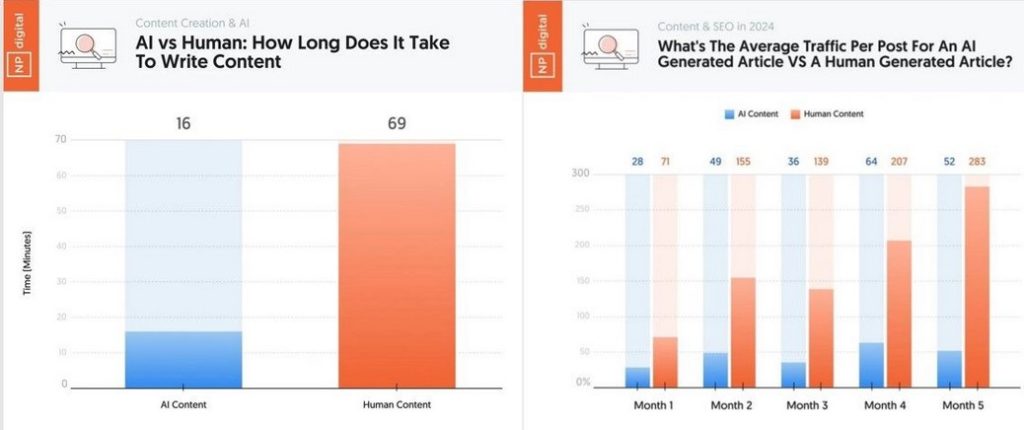
This post was born out of a long reflection over the weekend on content marketing. But also about blog, search engine optimization (SEO) and artificial intelligence.
In content marketing, do we write for search engines or for readers? And are we increasingly turning to artificial intelligence (the ChatGPTs of this world) to write our blog posts, as a way of wasting less time, making our lives easier, taking shortcuts?
Which led me to the following: a comparison between two texts generated by AI and one by a human (yours truly), all three answering the same “prompt”: “What are the most important tips to have an effective B2B marketing blog?”.
And it’s proven by a recent study by Neil Patel’s team that human-generated posts were, in addition to being satisfying, more effective. 🙂

So who’s going to be the most “human” of the three, while still meeting SEO standards and efficiency criteria?
➡️ The answer from GEMINI (Google)
Tips for an effective B2B blog :
- Define your goals and audience:
- What do you want to achieve with your blog? Generate leads, increase brand awareness, build customer loyalty?
- Who are your personas? What are their issues and needs?
- Create quality content:
- Add value for your readers with informative, relevant and engaging articles.
- Adopt a tone and style suited to your audience.
- Take care with the structure and formatting of your articles.
- Use images and videos to illustrate your points.
- Optimize your search engine optimization (SEO):
- Choose relevant keywords and use them judiciously in your titles, articles and meta tags.
- Create internal and external links to other relevant content.
- Optimize your blog’s loading speed.
- Promote and distribute your content:
- Offer a regular publication schedule to build reader loyalty.
- Relay your articles on social networks and in your newsletters.
- Use online advertising to reach a wider audience.
- Measure your results and analyze your performance:
- Use analytics tools to track your blog traffic, page views and conversions.
- Adjust your strategy according to your results.
Good blogging practices
EIn addition to these tips, here are some best practices for an effective B2B blog:
- Encourage comments and interaction
- Answer your readers’ questions
- Invite experts to write guest articles
- Organize contests and giveaways
By following these tips and taking a proactive approach, you can turn your B2B blog into a powerful tool for generating leads, increasing your visibility and growing your business.
Remember: the success of a B2B blog is built over time. Be patient, persistent and invest time and effort in creating quality content.
Good luck!
➡️ The answer from ChatGPT (Microsoft)
To have an effective B2B marketing blog, here are some key tips to follow:
1- Know your target audience: Understand the needs, challenges and interests of your target audience. Use in-depth research to identify topics and issues of interest to your B2B audience.
2- Offer quality content: Make sure your content is informative, relevant and engaging. Offer in-depth analysis, case studies, practical advice and real-life examples to deliver real value to your readers.
3- Maintain publication regularity: Establish a consistent editorial calendar and stick to it. Regular publication of new articles helps build audience loyalty and maintain engagement.
4- Optimize for search engines (SEO): Use relevant keywords in your titles, meta tags and content to improve your blog’s ranking in search results. Create internal links between your posts to reinforce your blog’s structure and improve its visibility.
I have to cut here for optimization reasons 🙂
5- Promote your content: Share your blog posts on social networks, in newsletters and on other platforms relevant to your target audience. Encourage your readers to share your content with their professional network.
6- Encourage interaction: Invite readers to comment on your articles, ask questions and share their own experiences. Respond quickly to comments to encourage engagement and active participation from your audience.
7- Establish your expertise: Use your blog to demonstrate your expertise in your field. Share practical tips, insights and case studies that show how your company can help customers solve their problems and achieve their goals.
8- Measure and analyze results: Use analytics tools to track your blog’s performance, including the number of visitors, bounce rate, time spent on page, and so on. Use this data to identify what’s working well and what can be improved.
By following these tips, you can create an effective B2B blog that attracts, engages and converts your target audience, strengthening your company’s presence and reputation in your industry.
*Please note that I have not corrected any mistakes, anglicisms or punctuation errors.
➡️ My answer (ExoB2B)
Creating content is a crucial aspect of any digital marketing strategy. Whether B2C or B2B. Blogging is one of the most popular tools used by many B2B companies. But writing is not enough.
If you want to make the most of your efforts, there are rules and best practices to follow. Simple tips that, even if you already know them, are always good to remember, so you can stay on top of the latest trends.
There are also suggestions straight from the world of SEO. Sponsored by the Yoast plugin on WordPress in particular. So, for a healthy B2B marketing blog, here are 15 tips:
- Analyze your market
- Aim for TOFU in the buyer’s journey
- Tackle subjects that highlight your expertise
- Cite your sources
- Add headings
- Add links, photos & videos
- Choose evocative titles
- Don’t try to sell, tell stories
- Write a punchline that generates engagement or CTA
- Check your spelling
- Index your posts (keywords/tags)
- Use Yoast SEO to “green” your posts
- Promote your posts
- Measure and evaluate (The importance of feedback)
- Correct, improve
Explaining all 15 in detail would take too long. So I’ll explain some of these ::
Who do you address in your blog?
In the course of blogging, we sometimes lose sight of who we’re addressing – or rather, who we should be addressing. Worse still, some blogs have been launched without any real planning, on the spur of the moment. But how do you engage your readers and turn them into potential customers (prospects) if you don’t even really know who they are? This is where a customer analysis makes all the difference.
Understanding your market and your customer base will help you paint a better picture of the average reader.
Or several portraits, in fact. These personas will each have interests, challenges and problems for which you can propose a solution.
If you’re writing for CEOs, but your readers tend to be technicians or engineers, your efforts will be in vain. Conversely, if you write highly technical content on your blog but the decision-makers who need your services are more likely to be in the finance department, they’re likely to get lost in your texts.
Knowing your blog’s audience is crucial.
It’s just as important to understand at which stage of the buyer’s journey to insert our posts. According to all the experts, blogs are used in all marketing niches or “Funnels” in good Chinese… but most effectively at the beginning of the buyer’s journey, (Top of Funne) more precisely during the Awareness phase.
This stage is crucial to attracting potential customers who are looking for information to understand and solve their needs or problems.
What’s the value of your content?
Why should your readers spend precious minutes reading your post? You need to offer them value, content that’s relevant and topical. Content that will teach them (or, at least, remind them) something important about their business or industry.
Well-defined personas will help you establish whether your content is valuable or not.
Each persona will offer avenues to explore for topics to cover. Each persona experiences little “bread and butter” miseries in their day-to-day professional life, and will be delighted to spend a few minutes reading a post that might be useful to them, and which moreover entertains them instead of putting them to sleep.
Don’t try to be famous, be useful! Whether it’s simplifying your readers’ decision-making, offering a solution to a problem they’re facing, or piquing their curiosity about how your company can improve their business. But you can’t just write for the sake of writing.
You have to offer value to the person who takes the trouble to read you.
But don’t try to sell products or services. You need to “tell the story” of the proposed solution to their problem.
Blog optimization and SEO
Obviously, you need to take good SEO practices into account when writing your text. We’re not talking about cheating by saturating search engines with keywords and tags. Remember those days? It doesn’t work that way anymore.
Good SEO practices, when followed, generally make your text more coherent and readable.
In addition to the presence of keywords in your titles, in your page URL and also in categories and tag clouds, there are other aspects that improve your text appreciably. Prefer short sentences or the judicious use of transition words, or add subheadings (h3) to better mark out your ideas. All these good practices will help your text flow more quickly and make it more enjoyable for the reader.
SEO is first and foremost for humans
But also for Google! 🙂
Finally, when I talk about “greening” your posts (#13), I’m referring to the mechanics imposed by Yoast in WordPress. In addition to what’s described above, Yoast will ask you to respect a hierarchy from H1 title to first paragraph in H2, with subheadings in the text in H3.
It will also suggest that you include internal and external hyperlinks. It will also ask you to have a target query and that this be found in the title (H1), in your introductory paragraph (H2), in your first paragraph of text and once or twice elsewhere in the text.
And note that Yoast or not, writing for the Web means writing short sentences. This is the Achilles’ heel of many a bolgueur.euses. Sentences that never end…
What’s the point?
Once all this has been accomplished, once the link has been clicked and your text read, what does the reader do?
The reader’s journey doesn’t have to stop at the end of your post.
Instead, point them in the right direction with calls to action (CTAs). In B2B marketing, the aim is, of course, to move them along the sales funnel.
Offer to download a guide or case study. Offer to subscribe to your newsletter. Insert links to your products and services throughout the text. You need to seize this opportunity and achieve a conversion; that is, achieve a particular goal with the reader.
What you want is to establish a first contact.
This first contact must also be generated by promoting your post(s) through traditional and social communication channels.
In B2B marketing, this means using LinkedIn in particular, but don’t limit yourself to social networks. You need to use the golden trifecta of digital marketing, or in other words: the EOP marketing mix (Earned, owned, paid media).
Conclusion
Both AIs responded factually. To get a human-like response, you’d have had to refine the prompts, which is more time-consuming than making a post yourself. In short, we’ll come back for less time (graph above left) or more convenience.
Who do you think gives the most human answer to the question, and in the best style? I invite you to contact us if you’d like more advice on content marketing blogs, or to carry out a customer analysis!






